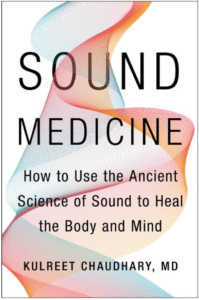Ever hear a song that makes you incurably sad or giddy with joy? Some experts believe there is a scientific precedence for this. Of course, music, and by extension sound, can have a powerful effect on the human body and mind. But there’s some health professionals who believe that sound may have genuine healing properties. This belief makes up the foundation of sound therapy. WellWell recently spoke with Dr. Kulreet Chaudhary, a neurologist and author of Sound Medicine: How to Use the Ancient Science of Sound to Heal the Body and Mind, about the growing medical support for sound therapy and how the practice may improve physical and mental wellbeing.
What is sound therapy and the ancient medicines that inspired it?
Sound therapy is a very broad umbrella term under which many things fall under. But the underlying premise is essentially that different forms of sounds—musical instruments, bowls, human voice, etc.—can have varied powerful impacts on human emotions. Ancient traditions primarily utilized the human voice, often creating sounds without any particular meaning but specific resonant frequencies. Sound therapy is the approach of applying these resonant frequencies and vibrations towards human healing.
What types of ailments or conditions can sound therapy help heal?
The ones most studied have been along the lines of psychological issues such as anxiety, depression, PTSD and even Alzheimer’s disease. All based on the assumption that sound has an effect on the brain and everything that is associated with mood or neurochemistry. It can have a huge impact on anything neurological.
Since you are a neurologist, can you speak a bit on the science behind this?
Truthfully, a lot of the science is still emerging but much of it is based the findings of successful sound and musical therapy treatments. One of the working theories focuses on the concept of resonance. The impact of the electromagnetic fields that sound creates. Those are measurable by an EEG and what they’ve found is music and sound have the capacity to project this resonant frequency, creating brain entrainment. Essentially the neurons in the brain beat in a particular way in response to music or sound.
How has the larger medical community responded to these findings?
Much of the science is still medically unconfirmed and needs further study but the findings are all quite positive and encouraging. Essentially, the medical community has concluded sound therapy can be effective but aren’t exactly sure why. A main reason the science is missing is because we don’t yet have a medicinal paradigm in modern medicine that explains vibrational therapy, of which sound medicine is one of the many therapies that falls under the umbrella of.
Have there been any advances in studying the field?
Absolutely. There is a new emerging system that’s called biofield science and it’s a bridge between the traditional medical model and holistic treatments. It looks at humans as more than just biochemistry and emphasizes their energy and the energy around them. The main reason we’ve yet to gain a firm scientific explanation of sound therapy is because we’re not operating within a medical model that looks at fields of energy as part of the biology of being human.
Why do you think it’s taken so long for traditional medical fields to give these holistic treatments like sound therapy a genuine look?
That’s a great question and one that I’ve asked for a very long time. Even as a trained neurologist, I’ve implemented holistic treatments that are truly much more effective than the ones in the arsenal I was taught. But I think overall there has been a slow shift happening in medicine towards more natural options. People are slowly starting to realize that these treatments have many of the same results without the nasty side effects of many traditional treatments. And that’s the core reason it’s taken so long, there’s just less of a financial incentive to propagate information that’s self-healing. No one’s really making money off sound therapy because it’s extremely low cost so there’s not going to be some huge pharmaceutical company that’ll be able to patent sound.
What’s causing the shift?
I think we’re starting to evolve the way we look at human life. It’s not black and white anymore, not just bones, muscles and neurons. We’re beginning to examine the genuine mind body connection and the impact of fields of energy. This is something that seems absolutely absurd a couple decades ago but is now becoming commonplace.
For those still stuck at home who may not have any experience, how can they start practicing sound therapy?
There’s obviously a bunch of this in my book, especially the last chapter which is a beginner’s guide on how to introduce sound medicine into your life. At the core of the practice is various mantras, chants and meditations. It can be generally accomplished with only 20 minutes a day, generating a resonant frequency to create certain alignments in the body and mind.
 About Dr. Kulreet Chaudhary
About Dr. Kulreet Chaudhary
Dr. Kulreet Chaudhary is the author of The Prime and Sound Medicine and has appeared as a medical expert on numerous programs including The Dr. Oz Show and Home & Family. She is also a neuroscientist and has participated in over twenty clinical research studies in the areas of multiple sclerosis, Alzheimer’s disease, Parkinson’s disease, ALS, and diabetic peripheral neuropathy. Dr. Chaudhary is currently the head of the Sri Narayani Holistic Centre in Tamil Nadu, India.
Learn More
drkulreetchaudhary.com
Facebook – @drkulreetchaudhary
Twitter – @DrKChaudhary
Mantra CD – music.apple.com/us/album/chakra-chant-ep













